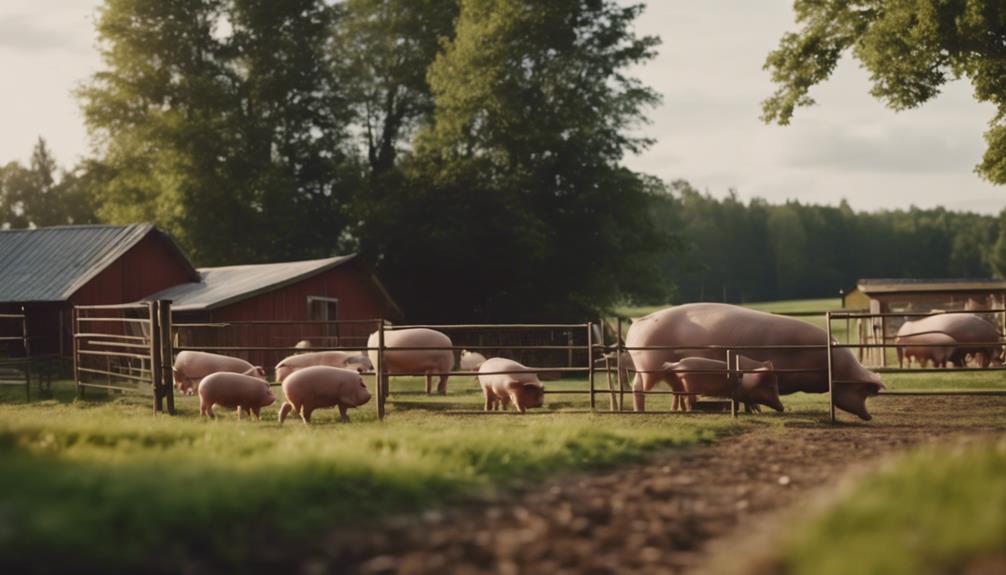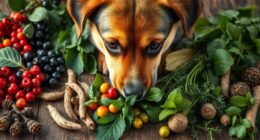Mastering market hog raising involves understanding key aspects like breed selection, housing, and nutrition. Choosing the right breeds, such as Duroc for fast growth or Berkshire for quality flavor, directly impacts profitability. Adequate housing requires attention to space and ventilation, ensuring hogs' comfort. A balanced diet is essential, as is regular health management, including vaccinations and monitoring. Preparing for market includes knowing target weights and local demand. Cost management through bulk purchasing and efficient housing reduces expenses. Engaging with customers via local markets or social media enhances sales opportunities, leading to successful hog raising ventures. More insights await on these vital topics.
Key Takeaways
- Choose the right hog breeds based on desired traits like growth rates, feed efficiency, and meat quality for market success.
- Ensure adequate housing and space, providing 20-40 square feet per hog to promote cleanliness and comfort.
- Implement a balanced diet that includes grains, protein, and vitamins, while ensuring proper hydration for optimal growth.
- Prioritize health management with regular veterinary care, vaccinations, and biosecurity measures to maintain herd health.
Breeds Selection for Market Hogs
Selecting the right breed for market hogs is vital, as it impacts growth rates, feed efficiency, and meat quality.
Farmers often consider popular breeds like Berkshire, known for its rich flavor and tenderness, or Duroc, which boasts fast growth and excellent feed conversion.
Hampshire's unique white belt and solid black body also attract attention for their quality meat.
Yorkshire, recognized for its adaptability and high-quality pork, remains a top choice as well.
Additionally, Tamworth offers a heritage option with a distinct flavor profile.
When selecting a breed, it's important to assess local climate compatibility, availability of breeding stock, and the temperament of the pigs to guarantee successful market hog production while meeting specific market demands.
Housing and Space Requirements
Proper housing and adequate space are vital for market hogs, as they greatly influence their health, growth, and overall well-being.
Each hog requires 20 to 40 square feet, while piglets need about 3 square feet. Designing pens to be longer than wide helps promote a clean environment, as pigs prefer separate areas for eating and sleeping.
A covered barn with proper ventilation protects them from extreme weather, while insulated housing guarantees comfort.
Strong fencing materials are important, with posts set 10 feet apart to prevent escapes and accommodate their natural digging instincts.
Providing clean bedding, such as straw or wood shavings, retains warmth and enhances comfort, contributing to the overall success of hog raising.
Nutrition and Feeding Strategies

A balanced diet is essential for market hogs, ensuring they receive the right mix of nutrients for ideal growth and health. Key components include grains, protein sources, vitamins, and minerals. Water plays an important role in digestion, with a requirement of 2-3 lbs for every lb of feed. It's important to adjust feed ratios based on weight, age, and health.
| Nutrient Type | Sources | Importance |
|---|---|---|
| Protein | Animal by-products | Muscle building |
| Carbohydrates | Corn, Wheat | Energy provision |
| Vitamins | A, D, E, K | Nutrient utilization |
| Minerals | Calcium, Phosphorus | Bone health and growth |
| Water | Fresh, clean sources | Essential for digestion |
Incorporating pasture grazing can enhance natural foraging behavior, contributing to their overall well-being.
Health Management Practices
Implementing effective health management practices is vital for maintaining the well-being and productivity of market hogs. Regular veterinary care, including vaccinations and deworming, keeps pigs healthy and reduces disease risk.
Owners should monitor hogs for signs of illness, such as lethargy, loss of appetite, or coughing, to catch issues early. Biosecurity measures, like controlling visitor access and sanitizing equipment, help prevent disease outbreaks.
Additionally, routine hoof care is essential to prevent lameness and guarantee mobility. Keeping detailed records of health treatments and vaccinations for each hog aids in tracking their health status over time.
Market Preparation Techniques

Effective market preparation techniques guarantee hogs reach ideal weight and quality for sale, maximizing profitability for farmers. Farmers should aim for a market weight between 240-280 pounds, monitoring growth closely to achieve this target.
Understanding local market conditions and pricing trends helps determine the best time to sell, securing optimal returns. Additionally, developing marketing strategies, such as utilizing local farmers' markets and online platforms, can enhance visibility and sales opportunities.
Selecting a reputable facility for processing is essential, as it directly impacts meat quality. Regular health monitoring and maintaining a clean environment also contribute to producing healthy, high-quality hogs.
Cost Management Tips
Cost management in market hog raising involves carefully balancing expenses while ensuring ideal care and growth for the animals.
By implementing smart strategies, hog farmers can reduce costs without sacrificing quality.
Here are some effective tips to evaluate:
- Buy in Bulk: Purchasing feed and supplies in bulk often leads to significant savings.
- Utilize By-products: Incorporate food by-products into the diet to lower feed costs.
- Regular Health Checks: Preventing illness through routine veterinary care reduces long-term expenses.
- Optimize Housing: Maintain clean, efficient shelters to decrease maintenance costs and improve animal comfort.
Marketing and Selling Strategies

To successfully market and sell market hogs, farmers should first understand their target audience and the local demand for pork products. Building relationships with local restaurants, grocery stores, and consumers can enhance sales opportunities. Utilizing social media and online platforms allows farmers to reach a broader audience.
| Strategy | Description |
|---|---|
| Local Farmers' Markets | Set up booths to sell directly to consumers. |
| Online Sales | Create an e-commerce platform for orders. |
| Community Engagement | Host farm tours and educational events. |
| Partnerships | Collaborate with local businesses for promotions. |
Frequently Asked Questions
What Are the Best Practices for Breeding Market Hogs?
When breeding market hogs, one must choose compatible breeds, maintain ideal health, guarantee a balanced diet, create proper housing, and monitor growth rates. Regular veterinary care and record keeping also contribute to successful breeding practices.
How Do I Handle Aggressive Behavior in Pigs?
Handling aggressive behavior in pigs is like steering through a stormy sea. He should identify triggers, provide ample space, and guarantee social structures are balanced, using calm interactions to foster trust and reduce tension among the herd.
What Are the Signs of Heat in Female Hogs?
When observing signs of heat in female hogs, she displays restlessness, increases vocalization, and becomes more affectionate. Additionally, she may mount other pigs and exhibit a swollen vulva, signaling readiness for mating.
Can I Raise Hogs Alongside Other Livestock?
Raising hogs alongside other livestock can create a harmonious farm ecosystem, as long as proper space and management are in place. They'll thrive, sharing pastures, while benefiting from the company of their fellow animals.
What Are the Environmental Impacts of Hog Farming?
Hog farming considerably impacts the environment, contributing to water pollution through runoff, greenhouse gas emissions, and deforestation for feed production. Sustainable practices can mitigate these effects, promoting a healthier ecosystem while maintaining productivity.
Conclusion
To sum up, mastering market hog raising means farmers must focus on essential facets: breeds, buildings, and balanced diets.
By prioritizing proper health management and strategic selling, they can pave the path to profitability.
With diligent dedication and savvy strategies, they'll not only nurture their hogs but also cultivate a successful, sustainable venture. By applying the same discipline and focus they used in implementing homeschooling success strategies, they’ll ensure that their farm operates with efficiency and purpose. This methodical approach allows them to adapt to challenges while maintaining a balance between innovation and tradition. Over time, their efforts will lead to both a thriving farm and a model for sustainable living.
Ultimately, a commitment to care and quality will guarantee their place in the competitive market, making their hard work truly worthwhile.










